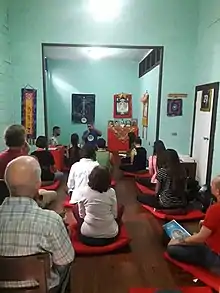| Part of a series on |
| Buddhism |
|---|
.svg.png.webp) |


Costa Rica has more Buddhists than the other countries in Central America with almost 100,000[1] (2.34% of total population), followed closely by Panama, with almost 70,000 (2.1% of total population).
Buddhism was introduced in the country for the first time by Chinese immigrants during the early 19th and 20th century, but an important part of these migrants later became --at least nominally-- Roman Catholics due to the then very Conservative Catholic-lead society. But there is registry that some of them kept their Buddhist believes practicing discreetly, for example, the testimony of writer Jorge Cardona of Buddhist altars among Chinese merchants in the early 20 century Puntarenas.[2] Another source of Buddhism in the country was the Theosophical Society, popular among important members of the economic and intellectual elite. Among the poets and theosophists that wrote Buddhist-influenced poetry are Roberto Brenes Mesén and José Basileo Acuña Zeledón. However one of the first Buddhist temples made in the country was the Casa Zen (Zen House) of Costa Rica created in 1974 with support of the Japanese government,[3][4] followed by the first Dharma Center of Tibetan Buddhism of the Gelug tradition founded in 1989 after the Dalai Lama's first visit to the country.
Nowadays, it is also driven by the very minor presence of Buddhist missionary groups, such as Soka Gakkai International., which has establish a community center at San Jose. [5]
In recent years there has been a tendency for growing dissatisfaction with Catholicism, the dominant religion. Some convert to other branches of Christianity, most notably Protestantism (with a growing number of Protestant churches throughout Costa Rica). But others stay as agnostics, atheists or "free thinkers". It is these latter groups, especially if already interested or practicing some form of meditation, that can become influenced or inspired by "exotic religions" (in Costa Rica) such as Buddhism and therefore convert to it, or adopt it as a philosophy.
Tibetan Buddhism
The four traditional schools of Tibetan Buddhism are present in Costa Rica.[2]
The best known and first group is the "Asociación Cultural Tibetano-Costarricense"[6] (Tibetan-Costarrican Cultural Association), which was established in 1989 CE after the first visit of the XIV Dalai Lama, Tenzin Gyatso in Latin America. Years later, in 2004 CE, the XIV Dalai Lama revisited Costa Rica.[7] He gave some discourses, including one in the University of Costa Rica and took part in ecumenical activities that included Costa Rica's archbishop. The Dalai Lama's third visit planned for 2008 was cancelled after the Costa Rican government under Oscar Arias Sánchez renewed relations with the People's Republic of China over Taiwan, resulting in soured relationships with the Buddhist community and criticism from the opposition. Opposition leader Ottón Solís publicly supported the Dalai Lama and promise to name the National Stadium in his honor in case he won the presidency.[8]
The ACTC runs the Thousand Eyes Compassive Buddha Dharma Center located in Barrio Amón, San José City. This center is of the Gelug tradition. There is also a Diamond Way Buddhist Center in Curridabat, San José (Karma Kagyu lineage)[9] and a Lingmincha Center of the Nyingma-Bon tradition.[10]
Zen Buddhism
The Casa Zen of Costa Rica center is located in Santo Domingo, Heredia.[11]
Others
There are also temples of Theravada Buddhism,[12] Shaolin[13] and a Chinese Buddhist Pagoda.[2]
References
- ↑ "Buddhism in Costa Rica". The Costa Rican News. 2012. Archived from the original on 16 December 2017. Retrieved 17 December 2017.
- 1 2 3 "El despertar de Buda". La Nación. 2012. Archived from the original on 22 December 2017. Retrieved 17 December 2017.
- ↑ "El nacimiento de la Casa Zen y los inicios del budismo en Costa Rica". Amelia Rueda. Archived from the original on 23 September 2016. Retrieved 17 December 2017.
- ↑ "Casa Zen de Costa Rica". Archived from the original on 22 December 2017. Retrieved 17 December 2017.
- ↑ "Historia". SGI Costa Rica. Archived from the original on 22 December 2017. Retrieved 19 December 2017.
- ↑ tibet in costa rica Archived 2017-03-28 at the Wayback Machine (official website, in spanish)
- ↑ Visit of H.H. the XIV Dalai Lama - 2004 Archived September 21, 2008, at the Wayback Machine (in spanish)
- ↑ "Ottón Solís Is "Putting Wood On The Fire" Of The Sino-Tibet Conflict". The Tibet Post. 2010. Archived from the original on 22 December 2017. Retrieved 17 December 2017.
- ↑ "Budismo Camino del Diamante Costa Rica". Facebook.com. Archived from the original on 3 March 2022. Retrieved 2 March 2019.
- ↑ "Find a Center or Sangha". Lingminch International. Archived from the original on 25 February 2018. Retrieved 19 December 2017.
- ↑ "Casa Zen de Costa Rica". Casazen.org. Archived from the original on 6 March 2019. Retrieved 2 March 2019.
- ↑ "Asociación de Budismo Theravada de Costa Rica". Archived from the original on 22 December 2017. Retrieved 17 December 2017.
- ↑ "Historia del Templo Shaolin". Shaolin.cr. Archived from the original on 14 December 2017. Retrieved 17 December 2017.